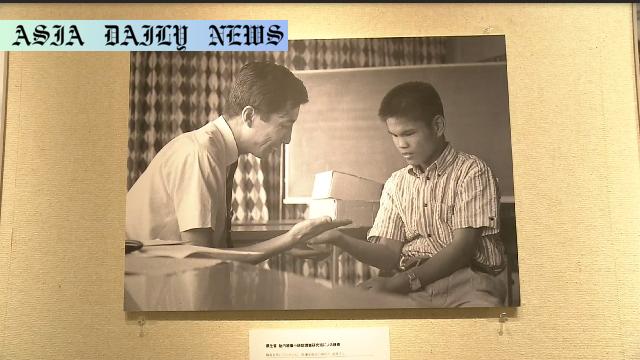Atomic bomb microcephaly: Exhibition showcasing 16 rare photos by Shigeta Masahiko and Suganuma Kiyomi reveals hidden stories.
Exhibition in Tokyo showcases 16 rare images of atomic bomb microcephaly survivors.
Photos from the 1960s and 1970s provide a glimpse into their daily lives and challenges.
Event hosted to mark 60 years since the founding of support group Kinokokai.
Aims to raise awareness about nuclear weapon effects and discrimination faced by survivors.

Introduction: A Unique Photo Exhibition in Tokyo
An extraordinary photo exhibition is currently taking place in Tokyo’s Nerima Ward, shedding light on a little-known chapter of atomic bomb history: people born with atomic bomb microcephaly. The exhibition coincides with the 60th anniversary of the Kinokokai group, an organization dedicated to supporting individuals with this condition. The displayed photographs, shot by talented photographers Shigeta Masahiko and Suganuma Kiyomi during the 1960s and 1970s, offer an intimate look at the lives of a rarely acknowledged group of atomic bomb survivors. The exhibition stands as a poignant reminder of the far-reaching and often overlooked human cost of nuclear weapons.
The Story Behind Atomic Bomb Microcephaly
Atomic bomb microcephaly emerged as a tragic consequence of the atomic bombings of Hiroshima and Nagasaki. These individuals were exposed to high levels of radiation while still in their mothers’ wombs. As a result, they were born with small head sizes, intellectual disabilities, and physical impairments. Referred to as the “youngest hibakusha,” they are a symbol of the intergenerational impact of nuclear warfare. Despite the severity of their conditions, little has been publicly discussed about their lives due to fears of exacerbating discrimination. This exhibition offers a much-needed opportunity to initiate understanding and empathy for these survivors and their families.
Insights from the Exhibition
The 16 photographs displayed at Tokyo’s Gallery Furuto are far more than historical artifacts; they are windows into the humanity and resilience of those affected. The images capture a range of experiences, from performing household chores to moments in hospitals away from family. Their families’ tireless advocacy for relief measures also features prominently in the exhibit. Most of these photos have never been made public before, reflecting the societal sensitivity surrounding the issue of atomic bomb microcephaly. However, Hirao Naomasa, a senior member of Kinokokai, hopes this exhibit will challenge audiences to rethink the stigmas linked to these conditions and understand the long-term consequences of nuclear warfare.
Raising Awareness and Promoting Change
This exhibition is not just about showcasing rare photographs; it is a call to action. By providing visibility to the youngest hibakusha, organizers aim to spur conversations about the devastating effects of nuclear weaponry, while emphasizing the importance of supporting vulnerable communities. The exhibition is especially timely in today’s geopolitical era, marked by renewed nuclear threats and heightened awareness of human rights. The stories told through these photographs underscore the need for a future free of nuclear weapons and greater advocacy for survivors’ rehabilitation and social inclusion.
Conclusion: A Step Toward Greater Understanding
The ongoing exhibition at Gallery Furuto is a profound and deeply moving experience. It captures the resilience of atomic bomb microcephaly survivors and uplifts their struggles, setbacks, and victories. In marking 60 years since the founding of Kinokokai, the event serves as a timely and significant reminder of the unseen costs of war. As visitors leave the gallery, they carry with them a deeper understanding of the lives affected by nuclear events and the urgent need to prevent such human tragedies in the future. The exhibition runs through Wednesday, offering a rare chance to witness history through the lens of empathy and humanity.



Commentary
The Importance of Shedding Light on Hidden Histories
The exhibition on atomic bomb microcephaly in Tokyo is a vital step toward preserving and sharing histories that have often been overshadowed. The youngest hibakusha have lived under the weight of both their medical conditions and the societal prejudices that accompany them. While the impact of the atomic bombings on Hiroshima and Nagasaki is a well-documented tragedy, this exhibition highlights an underrepresented group of survivors who continue to live with the consequences of that history. By making these 16 previously unseen images public, the organizers are not only honoring the resilience of these individuals but also fostering much-needed awareness about the devastating effects of nuclear warfare.
The Role of Visual Storytelling in Changing Perspectives
What stands out most about the exhibition is its reliance on visual storytelling to convey the lived realities of survivors. The photographs, taken decades ago, transcend time to deliver messages of resilience, struggle, and human dignity. There is something profoundly moving about seeing moments from the daily lives of those with atomic bomb microcephaly, whether it’s sitting at a dining table or advocating for their rights. These images go beyond the medical and historical documentation of the atomic bomb’s aftermath—they connect viewers to the personal experiences and challenges faced by the youngest survivals.
Looking Ahead: Why This Matters
In today’s world, where geopolitical tensions continue to raise concerns about nuclear weapons, exhibitions like this serve as critical reminders of the human cost of war. Beyond their historical significance, they challenge audiences to think about current and future implications of nuclear technology. The exhibition is not merely a retrospective exercise; it’s a call for empathy, education, and advocacy. By understanding the challenges faced by atomic bomb microcephaly survivors and their families, we are compelled to push for continued efforts to eliminate nuclear weapons and build a more inclusive society for all affected by past conflicts.